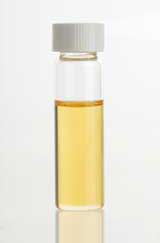Cedarwood oil is mainly used in industry as a fragrance and for its pesticidal properties.
It is also used to “revitalize” various wood products (e.g. furniture, fences, flooring, etc.).
Although there is no scientific evidence of cedarwood oil's effect on health, some people use it for medicinal purposes.
In aromatherapy, cedarwood oil is used especially in bath and massage oils. Read more about the many uses and properties of cedarwood oil here.

Properties of cedarwood oil
Undocumented properties
Below is an overview of the health properties often attributed to cedarwood oil. However, these properties are not scientifically proven and therefore not recognized in medical circles:
- Acne
- Rheumatic diseases
- Asthma
- Bronchitis
- Cough
- Dandruff
- Eczema
- Hair loss
- Kidney disorders
- Nervous tension
- Oily skin
- Psoriasis
- Seborrhea
- Stress and anxiety
- Bladder infections
- Urinary tract infections
It should be emphasized that there are no studies that have proven that cedarwood oil can in any way alleviate or prevent the above diseases and health problems. Therefore, you should not attempt to treat illnesses etc. with cedarwood oil – consult a doctor instead.
Investigated properties with missing documentation
- Streptococcus mutans: This bacterium lives in the human oral cavity and contributes to the development of carries (tooth decay). An Indian study from 2012 showed that cedarwood oil – as well as cinnamon oil, lemongrass oil, clove oil and eucalyptus oil – has an inhibitory effect on the bacteria. In practice, this means that cedarwood oil may be used as an alternative to existing antibacterial agents on the market. However, the basis of the study is too incomplete to be considered scientific proof that cedarwood oil can be used as an antibacterial agent for human use.
Documented properties
- Insecticide/fungicide: Although cedarwood oil can be extracted from several different types of wood and thus comes in many different varieties, they all have some degree of antibacterial and pesticidal properties. Most of the trees used to make cedarwood oil contain cedrol. The amount of this substance in each oil has a major influence on the pesticidal properties of the oil. In practice, cedarwood oil is therefore used to kill certain types of fungi and especially insects. However, it should be noted that cedarwood oil cannot be used as a biocide in the EU (due to the so-called Biocidal Products Directive 98/8/EC).
Uses of cedarwood oil
Industry
Cedarwood oil is mainly used in:
- Insecticides – including:
- Skin repellents (e.g. mosquito balm)
- Insecticides (e.g. sprays to kill insects, mosquito candles, etc.)
- Against moths (especially in the textile industry – cedarwood oil is also found in some mothballs, for example)
- Against vermin (especially fleas in pets)
- Fragrance in detergents, floor polishes and air fresheners
- Fragrance in soaps, lotions and cosmetics
- Fungicides (e.g. against mildew – a fungus that grows on plants)
- Cedarwood
- For protection and “revitalization” of cedar (tree houses, fences, etc.)
- For restoring the scent of old cedar furniture
Aromatherapy
Cedarwood oil can easily be combined with one or more of the following oils:
- Bergamot oil
- Cypress oil
- Cinnamon oil
- Frankincense
- Juniper berry oil
- Jasmine oil
- Lemon oil
- Lime oil
- Lavender oil
- Rose oil
- Orange blossom oil
- Rosemary oil
Cedarwood oil is mainly used as a massage oil and bath oil. In addition, cedarwood oil can also be inhaled, diffused (in the air) or applied directly to the skin (drip 2-4 drops directly onto the desired area). You usually don't need to dilute the oil before application – but always remember to read the instructions on the packaging.
Preparation
Although cedarwood oil can be extracted from cedar trees, today it is more common for the oil to come from trees in the Spruce family (Pinaceae) or in the Cypress family (Cupressaceae). Cypress oil is extracted from the needles and/or wood chips, sawdust and roots of trees by steam distillation.
The trees used to produce cedarwood oil include:
- Cedrus deodara
- Cedrus atlantica
- Cupressus funebris
- Widdringtonia whytei
- Juniperus virginiana
- Juniperus mexicana
- Juniperus procera
[/grid_col]
Precautionary measures
- Pregnancy: Pregnant women should not use cedarwood oil as there is uncertainty about its effect on fetuses.
- Children: Toddlers under 2 years of age should not come into contact with cedarwood oil (also due to uncertainty about the effects of the oil).
- Skin: Cedarwood oil may possibly damage the skin – especially in people with sensitive skin (test with small areas of skin if necessary).
- Long-term exposure: Studies have shown that people who work in industry (especially in sawmills) and are exposed to high levels of cedarwood oil on a daily basis for long periods of time can develop lung and liver damage. However, it should be emphasized that this only applies to long-term exposure to high levels of cedarwood oil and does not apply to ordinary consumers where contact with the oil is temporary and oil levels are low.
